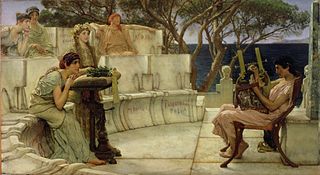Related Research Articles

This article concerns the period 599 BC – 590 BC.

Year 300 BC was a year of the pre-Julian Roman calendar. At the time it was known as the Year of the Consulship of Corvus and Pansa. The denomination 300 BC for this year has been used since the early medieval period, when the Anno Domini calendar era became the prevalent method in Europe for naming years. B.C.E is the abbreviation for before the Common/Current/Christian Era.
Year 194 BC was a year of the pre-Julian Roman calendar. At the time it was known as the Year of the Consulship of Africanus and Longus. The denomination 194 BC for this year has been used since the early medieval period, when the Anno Domini calendar era became the prevalent method in Europe for naming years.
Year 177 BC was a year of the pre-Julian Roman calendar. At the time it was known as the Year of the Consulship of Pulcher and Gracchus. The denomination 177 BC for this year has been used since the early medieval period, when the Anno Domini calendar era became the prevalent method in Europe for naming years.
Year 257 BC was a year of the pre-Julian Roman calendar. At the time it was known as the Year of the Consulship of Regulus and Blasio. The denomination 257 BC for this year has been used since the early medieval period, when the Anno Domini calendar era became the prevalent method in Europe for naming years.
Year 265 BC was a year of the pre-Julian Roman calendar. At the time it was known as the Year of the Consulship of Gurges and Vitulus. The denomination 265 BC for this year has been used since the early medieval period, when the Anno Domini calendar era became the prevalent method in Europe for naming years.
Year 285 BC was a year of the pre-Julian Roman calendar. At the time it was known as the Year of the Consulship of Canina and Lepidus. The denomination 285 BC for this year has been used since the early medieval period, when the Anno Domini calendar era became the prevalent method in Europe for naming years.
The year 546 BC was a year of the pre-Julian Roman calendar. In the Roman Empire, it was known as year 208 Ab urbe condita. The denomination 546 BC for this year has been used since the early medieval period, when the Anno Domini calendar era became the prevalent method in Europe for naming years.
The year 643 BC was a year of the pre-Julian Roman calendar. In the Roman Empire, it was known as year 111 Ab urbe condita. The denomination 643 BC for this year has been used since the early medieval period, when the Anno Domini calendar era became the prevalent method in Europe for naming years.
The year 642 BC was a year of the pre-Julian Roman calendar. In the Roman Empire, it was known as year 112 Ab urbe condita. The denomination 642 BC for this year has been used since the early medieval period, when the Anno Domini calendar era became the prevalent method in Europe for naming years.
The year 554 BC was a year of the pre-Julian Roman calendar. In the Roman Empire, it was known as year 200 Ab urbe condita. The denomination 554 BC for this year has been used since the early medieval period, when the Anno Domini calendar era became the prevalent method in Europe for naming years.
The year 613 BC was a year of the pre-Julian Roman calendar. In the Roman Empire, it was known as year 141 Ab urbe condita. The denomination 613 BC for this year has been used since the early medieval period, when the Anno Domini calendar era became the prevalent method in Europe for naming years.
The year 609 BC was a year of the pre-Julian Roman calendar. In the Roman Empire, it was known as year 145 Ab urbe condita. The denomination 609 BC for this year has been used since the early medieval period, when the Anno Domini calendar era became the prevalent method in Europe for naming years.
The year 644 BC was a year of the pre-Julian Roman calendar. In the Roman Empire, it was known as year 110 Ab urbe condita. The denomination 644 BC for this year has been used since the early medieval period, when the Anno Domini calendar era became the prevalent method in Europe for naming years.
The year 633 BC was a year of the pre-Julian Roman calendar. In the Roman Empire, it was known as year 121 Ab urbe condita. The denomination 633 BC for this year has been used since the early medieval period, when the Anno Domini calendar era became the prevalent method in Europe for naming years.
The year 582 BC was a year of the pre-Julian Roman calendar. In the Roman Empire, it was known as year 172 Ab urbe condita. The denomination 582 BC for this year has been used since the early medieval period, when the Anno Domini calendar era became the prevalent method in Europe for naming years.
The year 686 BC was a year of the pre-Julian Roman calendar. In the Roman Empire, it was known as year 68 Ab urbe condita. The denomination 686 BC for this year has been used since the early medieval period, when the Anno Domini calendar era became the prevalent method in Europe for naming years.
The year 698 BC was a year of the pre-Julian Roman calendar. In the Roman Empire, it was known as year 56 Ab urbe condita. The denomination 698 BC for this year has been used since the early medieval period, when the Anno Domini calendar era became the prevalent method in Europe for naming years.
Duke Hui of Qi was from 608 to 599 BC ruler of the State of Qi, a major power during the Spring and Autumn period of ancient China. His personal name was Lü Yuan (呂元), ancestral name Jiang (姜), and Duke Hui was his posthumous title. He was known as Prince Yuan before ascending the throne.
Duke Qing of Qi was from 598 to 582 BC ruler of the State of Qi, a major power during the Spring and Autumn period of ancient China. His personal name was Lü Wuye (呂無野), ancestral name Jiang (姜), and Duke Qing was his posthumous title.
References
| This BC year article is a stub. You can help Wikipedia by expanding it. |